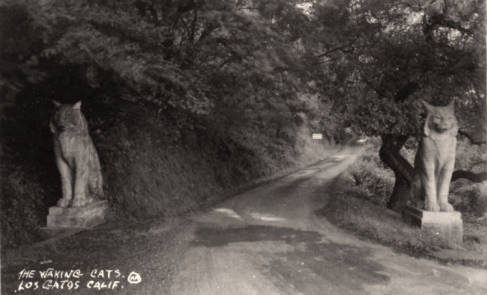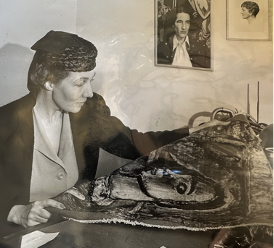Our Newest Member
New member David Mostardi, a graduate of UC Berkeley, is the historian at the Berkeley Hillside Club, a community-based membership organization founded in 1898 and dedicated to supporting arts and culture and preserving landmark buildings. Since 1997, David has been researching bookseller-publisher Paul Elder (1872–1948) and his early business partner, Morgan Shepard (1865–1948); he also writes the Paul Elder & Company website, paulelder.org. For 70 years, Paul Elder’s was the leading bookstore in downtown San Francisco, and between 1898 and 1917, Elder published over 400 books. Shepard, who left the partnership in 1903, would later publish the children’s magazine, John Martin’s Book. David’s forthcoming book, A Western Publisher: Paul Elder & Company (1898–1968), is scheduled for publication in 2026 by the Book Club of California. David also leads field trips for the Golden Gate Bird Alliance and plays accordion for Scottish Country Dancing. He lives in Berkeley with his wife, Arlene Baxter.
What our members were up to this summer . . .
On August 21st,
Jody Offer led a read-it-yourself of her five-act play,
Scenes from the Life of Julia Morgan, at the Emeryville Senior Center. Jody noted that the group seemed to be having a very good time, staying for a long Q&A and then asking her to “come back with another play.” Jody reported, “They had a lot of questions about Julia; I think it’s safe to say they knew very little about her when they walked in. If any Institute members know of groups who might be interested in having this experience, forward me a contact and I will check it out.”
Maria Sakovich gave the keynote talk at the recent one-day conference, “The Story of Orthodoxy at Fort Ross—Then and Now,” held at St. Seraphim of Sarov Cathedral in Santa Rosa on Friday, October 3rd. Her presentation, “The Beginnings of the Annual Pilgrimage to Fort Ross,” recalled the collaboration between San Francisco’s Holy Trinity Cathedral and the Sonoma County Native Sons of the Golden West, the difficulties of traveling to the former settlement of the Russian-American Company (RAC) on the coast, and the significance of this piece of old Russia to recently arrived refugees from the Bolshevik revolution and civil war in the 1920s. Maria’s grandfather, Archpriest Vladimir Sakovich, was the first to perform services in the old chapel in 1925, 84 years after the RAC abandoned the settlement. This past Fourth of July celebrated the 100th anniversary of the pilgrimage to Fort Ross.
John Graham is busy working on the follow-up to his El Fornio Story Cycle. His working title is The Moorish Box (La Caja Morisca) and has the same characters as his first book about the fictitious mission town, El Fornio, California, founded in 1776 north of Santa Barbara. This new narrative concerns the Spanish horsemen who came to the New World and California who were actually Arabs—expelled Christianized Moors with a talent for horsemanship and their contemporary descendants. The story takes place at El Fornio and Tejon Ranch, where the “Cross and Crescent” is the ranch’s livestock brand and This new narrative concerns the Spanish horsemen who came to the New World and California who were actually Arabs—expelled Christianized Moors with a talent for horsemanship and their contemporary descendants. The story takes place at El Fornio and Tejon Ranch, where the “Cross and Crescent” is the ranch’s livestock brand and is the oldest brand still in use in the country. John shares his book’s teaser here: “Taken for Native American or Mexican all her life, Dolores Huerta had been told by her family that
they were Moors from Spain, the progeny of Spanish horsemen who came to the New World after 1492. When her favorite uncle, Carlito Zaragoza, passes and leaves a mysterious box and letter, ‘Lo’ and her partner Hank Peabody, Jr., director of the El Fornio Historical Society, set off to locate a second box that might bring all the secrets together. This follow-up to The Reeducation Of A Turd Peddler finds the same crew chasing another California fairy tale. They found Junipero Serra’s heart in a jar, but can they find the second box?”
Katya Miller was a panel participant during the 118th annual meeting of the Pacific Coast branch of the American Historical Association. The three-day meeting, which began on July 30th, was held at Santa Clara University and was entitled “High-Stakes History: Studying the Past in a Perilous Present.” Katya was placed on a panel called “Memorable Women Remembered” with two other speakers and presented “The Nearly Forgotten Female Icon Atop the Capitol Dome” as an independent scholar. She drew upon her decades of researching the history of the Statue of Freedom for her presentation. The other panelists presented "Girls Get Rough: Women’s Self-Defense in the United States During World War II" by Wendy Rouse, San Jose State University, and "Miss Monroe and the Lost Women’s Art Colony of Manifest Destiny" by Nicholas Fischer, an independent scholar.
Katya found the rest of the conference quite educational and rewarding. She attended the panel “Indigenous Sovereignty and Autonomy: Indigenous History and the West” and heard talks on Spanish-Hawaiian immigrants in California, the role of the historian, and doing history differently. At the Western Association of Women Historians luncheon, she learned that next year’s conference in Sacramento will focus on where history, research, and networking meet. She strongly encourages our members to check out next year’s gathering.
Oliver Pollak gives a fascinating account of the book collection of his aunt and mother, all three of which made it safely out of Germany during World War II, in the latest issue of The Book Club of California’s Quarterly News-Letter (Summer 2025, Volume XC, Number 3). Club executive director and newsletter managing editor Kevin Kosik notes on his editor’s page, “Oliver B. Pollak shares the story of his family and the books they took with them when they fled Germany in 1939. As family history and book history converge during war times, this text is a powerful exploration of what we collect and why.” Oliver’s essay, entitled “Two Sisters – My Aunt and Mother – Rescue Books from Germany in 1939” is part of the Club’s “Collector Chronicles,” a “series of essays from members about unique, unusual, or significant items in their collections.” Oliver would be pleased to send a scanned copy of the piece to any member who requests one. His email address is
obpomni@gmail.com.
Your editor, Rose Marie Cleese, has been wearing her editor’s cap pretty nonstop the past few months. In addition to helping member Katya Miller get her manuscript about the Statue of Freedom at the US Capitol across the finish line, she was also contracted by Kevin Kosik at the Book Club of California to do the final edit of new member David Mostardi’s book about publisher Paul Elder. She also was hired to write the intriguing life story of the mother of Merle Easton; the family lived in Alaska during and after World War II. With that project done, Rose Marie is now starting on ghostwriting a longer memoir of Merle’s life; Merle is a retired architect and well-known San Francisco Victorian building preservationist. Rose Marie will also be helping another client write a book about the vintage restaurants of San Francisco from 1849 to the 1990s. Whew!
Members: Please submit news of your history-related publications, lectures, awards, research finds, etc. to info@instituteforhistoricalstudy.org.

 The California and the West study group invites you to tour the exhibition at the History Museum of Los Gatos, American Bohemia: The Cats Estate in Los Gatos. The exhibition explores the storied lives of Charles Erskine Scott Wood and Sara Bard Field, acclaimed literary figures and intellectuals, and their home, which became a gathering place for some of America’s most significant artists and writers, including Robinson Jeffers, Ansel Adams, John Steinbeck, Ralph Stackpole, and Lincoln Steffens. Please contact Ann Harlow if you are interested in the 2:00 p.m. tour, and let her know if you would like to have dinner in Los Gatos and attend the 7-9 p.m. program, “a salon-style evening of conversation, food, and drink with scholars of the lives of Sara Bard Field and C.E.S. Wood and their time in California.” The program will take place at the Former Los Gatos Library, future home of The Museums of Los Gatos.
The California and the West study group invites you to tour the exhibition at the History Museum of Los Gatos, American Bohemia: The Cats Estate in Los Gatos. The exhibition explores the storied lives of Charles Erskine Scott Wood and Sara Bard Field, acclaimed literary figures and intellectuals, and their home, which became a gathering place for some of America’s most significant artists and writers, including Robinson Jeffers, Ansel Adams, John Steinbeck, Ralph Stackpole, and Lincoln Steffens. Please contact Ann Harlow if you are interested in the 2:00 p.m. tour, and let her know if you would like to have dinner in Los Gatos and attend the 7-9 p.m. program, “a salon-style evening of conversation, food, and drink with scholars of the lives of Sara Bard Field and C.E.S. Wood and their time in California.” The program will take place at the Former Los Gatos Library, future home of The Museums of Los Gatos.



